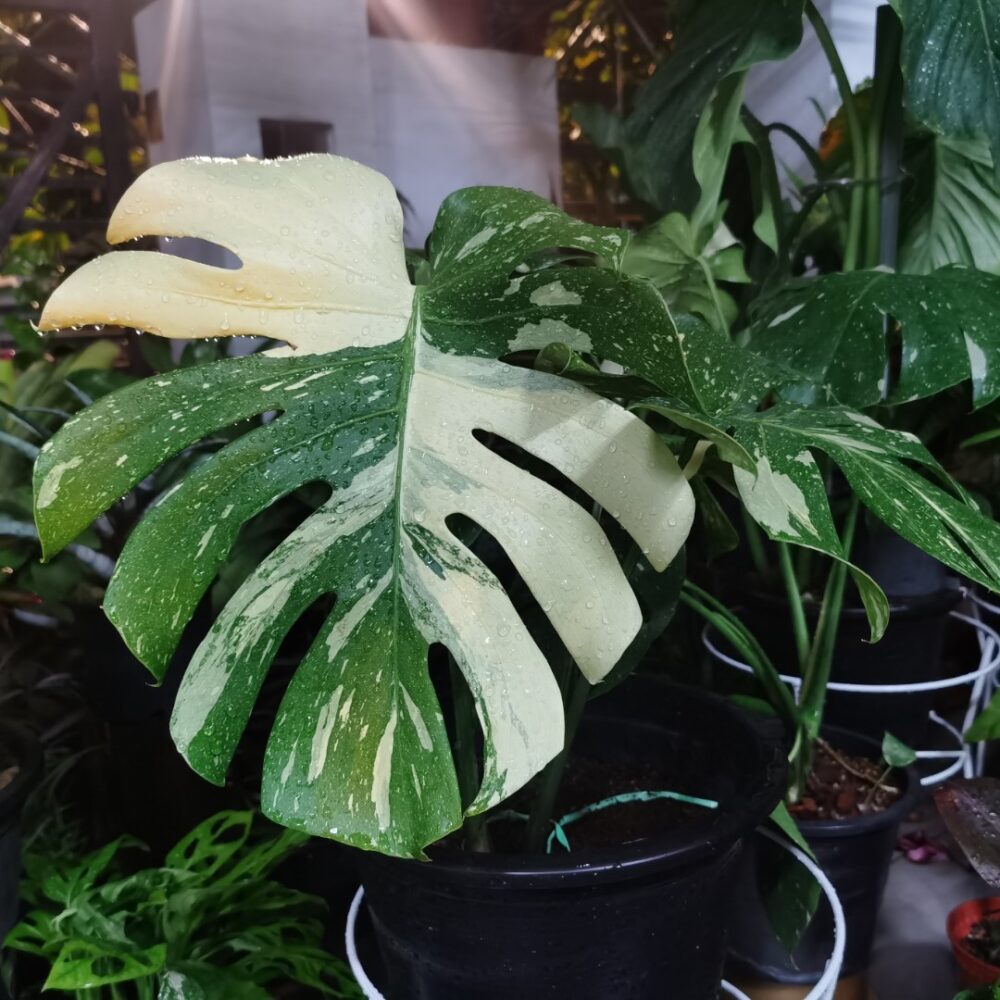Monstera Thai constellation is a true gem among indoor plants with its unique appearance and simple maintenance. It will refine and enrich every living room, making it a pleasant and joyful place to spend your time. If you are also a Monstera Thai constellation addict, discover the top 5 interesting things you need to know about Monstera Thai Constellation in the article below.
What is Monstera Thai Constellation?
Monstera Deliciosa was born in a tropical setting and gets its wonderful name from the fruit known as swiss cheese or fruit salad. It has a flavor that is comparable to that of other tropical fruits.
The lack of chlorophyll in Monstera Deliciosa Thai Constellation accounts for its unusual look of green leaves speckled with white or creamy patterns. Its name derives from the Thailand laboratory, where it was developed and received some remarkable looks.
The Monstera’s green background is sprayed with creamy yellow segments, turning it into a work of art. This occurrence has the overall appearance of a starry sky. This is where the Constellation portion of the variety’s name originates from.

Soil Requirements
Make sure the soil is well-drained if you want your plant to live and grow into a healthy and tasty example. That is the most crucial stage in maintaining a healthy environment for the Monstera family, and I cannot emphasize it enough.
If the water remains at the bottom of the root, it will become mushy and finally rotten. And you’re well aware of the implications for the entire plant.
Of course, this isn’t just attributable to the type of soil in which your plant grows. That, too, is dependent on the pot. It has to be the one with a decent drainage system so that water does not accumulate.
Furthermore, perlite and bark should be added into the soil to ensure that the drainage process runs smoothly.
Light Requirements
When it comes to lighting, we must keep in mind that every living species requires sufficient light to live and develop normally.
However, we must keep in mind that too much light might be detrimental. It can harm both our skin and the leaves of plants.The fundamental reason for this is that the white regions of the leaf are poor in chlorophyll. Chlorophyll is an important component of the photosynthesis process.
With this in mind, we must give a brighter environment for Thai Monstera Constellation than for other varieties that do not suffer from chlorophyll shortage. This does not, however, imply that we must relentlessly expose it to direct sunshine.
There must be enough of lightning, but it must be filtered or dispersed through transparent curtains or windows with some texture on the glass.
Watering Requirements
Watering, like lighting, is a game of finding the right balance. Never forget that Thai Monstera is a forest species and a member of the Monstera family. Its ideal setting would be a tropical jungle.
This indicates that it enjoys moist soil, but keep in mind that water must circulate. Allowing the roots to sink in the water is never a good idea.
This is the recommendation, and you should memorize it. Allow the soil to never dry out or become soaked with water. Neither are good for the plant’s health.
What will you do if you don’t know when it’s time to water the plant? This question does not have a perfect answer. However, by performing a simple test with your finger, you may view and inspect the plant.
This is approximately one to two times per week during the colder months of the year. During the warmer summer months, though, it will be required to do so more frequently. Let’s say every two days or so.

Humidity and Temperature Requirements
Because it’s a tropical plant, Monstera Deliciosa Thai Constellation thrives in hot, humid conditions. It may appear to be contradictory, yet it is possible with a little effort.
During the winter, the temperature must be at least 13 degrees. It thrives best in temperatures between 24 and 26 degrees Celsius in the summer (75-78 Fahrenheit).
During the colder months, when our houses’ heating systems are continuously on, ensure sure the air in the room where your Thai beauty resides is not dry. You can obtain the ideal humidity level in a variety of methods.
The simplest method is to saturate the plant with water droplets, preferably soft water. To renew it, give it a full shower in the bathroom with lukewarm water.
Never, ever, ever, ever, ever, ever, ever, ever, ever, ever, ever, ever, ever, ever, ever Give them a good shower or clean them with a moist cloth. If you have some spare cash, you might want to consider purchasing a humidifier to prevent air dryness.
Fertilizer Requirements
When it comes to fertilization, don’t forget to give your plant adequate balanced nutritional ingredients to help it grow gradually. In the spring and summer, most house plants will benefit from fertilizing. There is no exception when it comes to Thai Constellation.
The fertilizer should be administered once a month throughout the active growing season, which is the summer and spring months. If you want your plant to grow and progress normally, organic houseplant fertilizer may be the finest option.
Slow-release fertilizers are something I would recommend. It means that a modest quantity of nutritious ingredients are delivered into the soil at regular intervals and in a consistent manner. If you opt for liquid fertilizer, make sure to read the instructions carefully to establish the proper dosage.
Now that you have come to the end of the article about top 5 things you need to know about Monstera Thai Constellation. Hopefully, this article has provided you many helpful knowledge to nurture your love with Monstera Thai Constellation.
If you have any question, let Xanh Xanh know in the comments and freely share it to your friends.

